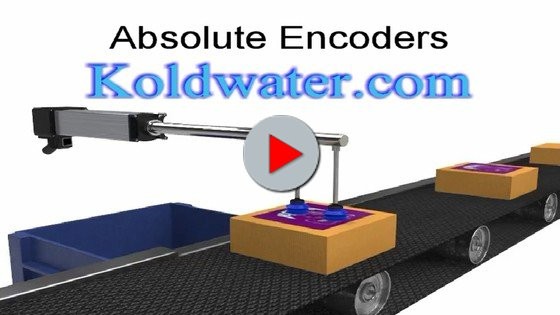Koldwater Training Software
Training Applications for the Electrical Controls Industry
Training
Software

Koldwater Training Software
Training Applications for the Electrical Controls Industry
Training
Software


Absolute encoders are used in many applications that require speed, position, angular displacement, and directional feedback. An encoder is a device that converts linear or rotary movement into digital or pulse signals. The most common type of feedback device is the absolute optical encoder. An absolute encoder consists of four major components ...
The encoder disk consists of a series of opaque and transparent tracks mounted to a rotating shaft. The tracks of the disk are arranged concentrically around the center of the shaft. Photodetectors are assigned to each track and designate the resolution of the encoder. The higher the number of concentric tracks, the higher the accuracy. A light source located on the opposite side of the photocell passes light through a capture plate. As the encoder disk rotates, light is either transmitted or blocked according to the pattern. The received light provides a four-bit word that indicates the position of the actuator or device that the encoder is mounted to.
The most common types of numerical encoding are decimal binary and gray code. In a 4-bit encoder, there are 16 unique combinations or numeric codes every 22.5 degrees. Gray code is designed where only one bit changes at a time, contrary to a binary system where one or more numbers change in the word of memory. By changing more than one number of the data word at a time in the binary system, the possibility of positioning errors is greater, leaving gray code the preference in precision applications for robot applications.
Absolute encoders are commonly used for precise positioning operations. The actuator in the video example, demonstrates the function of the absolute encoder in operation. As the actuator moves to push the carton in the video, the encoder provides feedback that it has reached the user-defined position. The actuator then moves back to the home position, verified by the encoder and completing the cycle. Using feedback devices closes the loop in motion control systems.
Expanding on above, a 'quad' encoder is 4 times the tracks, or 4X4 bits=16 bits (1 word of data). The largest decimal value that a 16-bit word of memory can hold using binary coding, is 32767. That is a lot of pulses per revolution! Given the relatively small size of an encoder disc, the quad encoder can be thousands of pulses per second given the RPM. So for a PLC to count those pulses and measure speed or position, a standard 16-bit (channel) discrete input card will not do. You need a special input card that is called a High-Speed Counter Card, like the Allen Bradley 1746-HSCE card. Why? Because the quad encoder will put out pulses quicker than the scan cycle of the PLC. So the HSC card stores the counts (pulses) measured, then passes that value on to PLC each scan cycle. These cards have 4 channels, so you can wire up to 4 quad encoders to them.